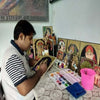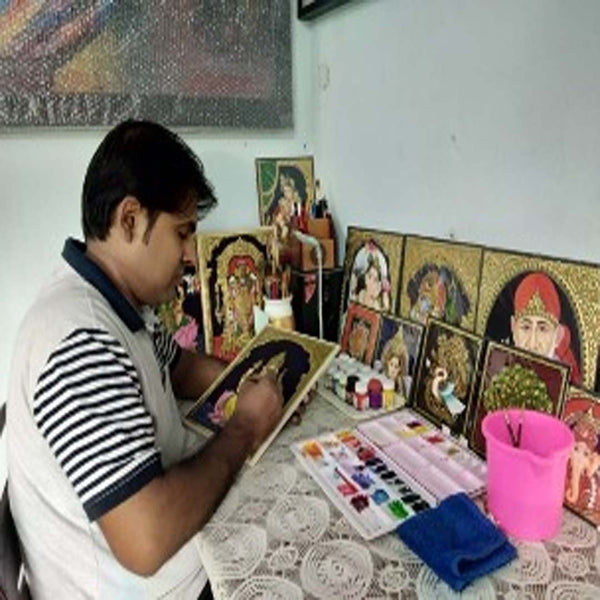Dimensions : H-15 W-12 inches
Medium : Poster Colors on Waterproof Plywood
![]() Earn upto 14,000.00 Points on purchase of this product.
Earn upto 14,000.00 Points on purchase of this product.
![]() Get upto 10% OFF on Live Workshops when sign up for 2 or more workshops.
Get upto 10% OFF on Live Workshops when sign up for 2 or more workshops.
![]() Get 10% OFF coupon code for Art Kits signing up for Masterclass or Live Workshop.
Get 10% OFF coupon code for Art Kits signing up for Masterclass or Live Workshop.
About the Artwork +
Renowned artist Sanjay Tandekar's "Maa Lakshmi - Goddess of Wealth and Fortune" in Tanjore Painting is a mesmerizing artwork that celebrates the rich heritage of this ancient Indian art form. With intricate detailing and vibrant hues, Tandekar brings to life the divine presence of Maa Lakshmi, the Goddess of Wealth. Tanjore painting, originating in the 16th century in Tamil Nadu, showcases exquisite craftsmanship and devotion. The use of gold leaf embellishments adds opulence to the composition, symbolizing prosperity. The color theory, blending deep reds, lush greens, and radiant gold, creates a visual symphony that encapsulates the goddess's benevolence. Ornate patterns and motifs, inspired by traditional South Indian architecture, adorn the painting, further enriching its cultural significance. Tandekar's work is not just a painting; it's a portal to the divine, inviting you to immerse yourself in the aura of abundance and spirituality.
Authentication +
Each of our artworks are hand painted by master artists across India. We provide an authentication certificate with this artwork signed by the artist.
Sizes and Customisation +
The sizes mentioned are excluding the borders of the artwork.
Frames shown are for visual representation only and are not included with the artwork.
We take custom artwork orders, please use the WhatsApp chat below or email us at wecare@memeraki.com to discuss your requirements in more detail.
International Shipping and Taxes +
We ship worldwide, Our Prices are inclusive of GST/Taxes in India. For International Orders, any specific custom duties you may encounter in your home country during the delivery has to borne by the buyer.
For all artworks expect Lippan and Terracotta, No additional charges are applicable for domestic deliveries. For International Orders shipping charges of 2000 INR are applicable.
For Lippan and Terracotta Artworks, We charge a Shipping rate on a per Kilogram basis. You can see your final Shipping Rate before checkout or view our pricing here.
Shipping and Returns +
All artworks are packed and couriered securely in a tube.
Ready To Ship/ In Stock artworks are shipped in under 2 weeks. We only accept return requests for Ready to Ship/ In stock artworks placed within a week from date of delivery.
Made To Order artworks will take 2-3 weeks to be made and shipped once they are ready. Returns are not applicable on Made To Order artworks.
Colour Disclaimer+
All artworks on the website are hand painted from scratch by our master artists. That makes every artwork absolutely unique and the actual colour and overall artwork may vary slightly from the artwork image posted here.

















